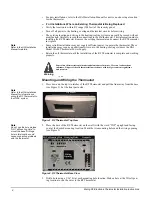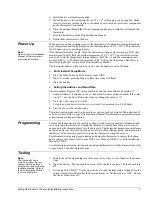
1
)
ZZZ*(,QWHUORJL[6HFXULW\FRP
,QVWDOODWLRQ,QVWUXFWLRQV
*(,QWHUORJL[
Product
Summary
The Dialog RF Electronic Thermostat provides a money-saving and convenient way to
monitor and control temperatures by integrating heating and cooling with energy saving
functions, while being supervised by a security system. The thermostat provides standard
control of a heating/cooling system while maintaining a wireless communications link to a
security system. The wireless link allows the security system to supervise the thermostat for
energy saving setback features (high and low limits).
The thermostat is designed for use with standard 24 VAC control of single stage heating/
cooling systems. It can also be used with two-stage heating/cooling systems that can be con-
trolled by a single-stage thermostat.
Heating/cooling system control is independent from the security panel. The thermostat con-
tinues to control the heating/cooling system even if the security system fails or is disabled.
Heating/cooling systems that use proprietary or non-standard control methods may not be
suitable for use with this thermostat.
Note
Consult the heating/cooling
system documentation for
more information.
The Dialog RF Electronic Thermostat is compatible with Simon
®
3 panels versions 3.3 and
later.
Installation
Installation of the Dialog RF Electronic Thermostat includes tools and supplies needed,
guidelines for installing and mounting the thermostat.
Tools and Supplies
•
Screwdrivers (Phillips and Flathead)
•
Screws and anchors (included)
•
Digital voltmeter
•
Drill with bits
•
Wire cutters/snippers
•
#18 solid wire OR multi-conductor thermostat cable (for new installations)
•
Pen or pencil
Installation Guidelines
Refer to the HAI RC-80 Installation Manual (13I00-1) for detailed installation instructions.
In addition to the HAI instructions, observe the following guidelines:
¾
For New Installations
•
Make sure your heating and cooling systems are working properly before installing the
RF Thermostat.
•
Turn off all power to the heating, cooling and thermostat circuits before wiring.
•
Avoid installing your RF Thermostat on plaster walls with wire mesh (metal lath)
embedded in them. This can interfere with the wireless range/communication between
the RF Thermostat and the panel.
•
Use 5 conductor thermostat wire and connect 24 VAC to the C terminal of the thermo-
stat.
•
Install the RF Thermostat on an inside wall within RF range (100 feet) of the security
panel.
'RFXPHQW1XPEHU5HY%
1RYHPEHU
'LDORJ5)(OHFWURQLF
7KHUPRVWDW
Model No.
60-909-95
























